Introduction
High-ticket digital products offer a unique opportunity for affiliates, entrepreneurs, and digital marketers to earn substantial commissions with fewer sales.
Whether you want to promote premium software, online courses, or high-end coaching programs, this guide will show you where to find high-ticket products and how to sell them effectively.
If you’re looking to build a profitable online business in 2025, mastering high-ticket affiliate marketing and sales strategies is essential.
This guide will cover everything from finding the best high-ticket affiliate programs to closing deals with premium buyers.
For a foundational understanding, check out our What Is High-Ticket Affiliate Marketing? guide.
Key Takeaways
High-Ticket Digital Products — What to Know
- High-ticket digital products are no longer a niche trend; they’re becoming the backbone of online business in 2025.
- The most profitable categories aren’t random; they’re the ones solving urgent, high-value problems buyers can’t ignore.
- Selling these products isn’t about hype, it’s about building trust with funnels, authority content, and proof buyers believe.
- The real power of high-ticket digital products? Fewer customers, more revenue, and an audience that actually sticks.
- The next wave is already here: AI-driven tools, certification programs, and turnkey services are reshaping the high-ticket landscape.
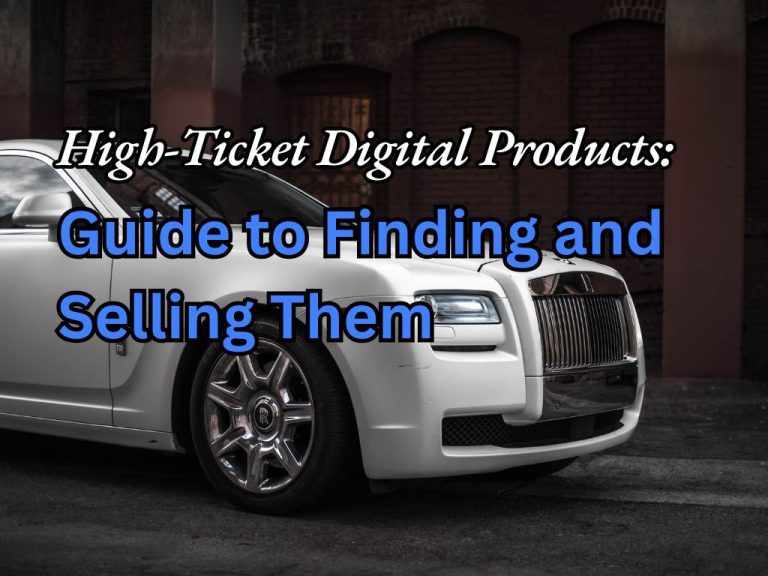
What Are High-Ticket Digital Products?
High-ticket digital products are premium online offerings designed to deliver transformation, not just information.
Unlike low-cost eBooks or quick templates, these are comprehensive solutions: advanced online courses, enterprise-level software, exclusive coaching, or done-for-you services built to solve complex, high-stakes problems.
They naturally attract business owners, professionals, and entrepreneurs who value speed, depth, and results. Instead of chasing low-priced options, these buyers are willing to invest in digital products that save them time, unlock new skills, or generate measurable growth.
At their core, high-ticket digital products are about outcomes. They don’t just promise knowledge, they promise change, whether it’s scaling a business, mastering a high-demand skill, or streamlining operations with powerful tools.
Best Categories of High-Ticket Digital Products in 2025
High-ticket digital products aren’t just about premium pricing, they’re about premium outcomes. These categories consistently perform because they deliver transformation that buyers can see, measure, and feel.
Whether it’s a course that unlocks a new career path, a SaaS tool that streamlines operations, or a mastermind that opens doors to elite networks, these products justify their price by solving urgent problems.
The categories below highlight where serious demand meets serious value, making them the most profitable opportunities for affiliates, creators, and entrepreneurs in 2025.
🏆 Best Categories at a Glance
| Category | What It Delivers | Ideal Buyers | Why It Works |
|---|---|---|---|
| Online Courses | Comprehensive training with clear, measurable outcomes. | Professionals, entrepreneurs, skill-seekers. | Seen as career or business investments, not just content. |
| Software & SaaS Tools | Enterprise-level solutions for automation and growth. | Businesses that need efficiency and scalability. | Recurring billing builds predictable, long-term revenue. |
| Premium Coaching Programs | Personalized 1:1 or group mentorship. | Business owners, leaders, individuals seeking tailored growth. | High-touch value makes premium pricing feel justified. |
| Digital Memberships & Masterminds | Exclusive access to knowledge, strategies, and networks. | Ambitious professionals, entrepreneurs, high-achievers. | Retention + recurring payments = compounding revenue. |
| Done-for-You Services | Complete turnkey solutions (funnels, automation, systems). | Busy entrepreneurs and scaling companies. | Delivers speed + expertise, reducing friction for buyers. |
Why These Categories Matter
What makes these categories powerful isn’t just their price point, it’s the mindset of the buyers behind them. People who invest in these products are seeking growth, speed, and clarity. They aren’t casual shoppers; they’re committed decision-makers ready to act when the solution is right.
If you’re looking to build a sustainable high-ticket business, aligning with one of these categories gives you a foundation where trust, authority, and profitability naturally overlap.
Why High-Ticket Digital Products Are Profitable
The profit potential of high-ticket digital products comes down to one principle: leverage. Instead of chasing hundreds of low-cost sales, one carefully positioned product can generate the kind of impact and income that low-ticket sellers spend months pursuing.
The advantages compound quickly:
- Bigger wins with fewer sales: Selling a premium solution means you don’t need endless traffic or thousands of customers. A smaller, committed audience is enough to create sustainable income.
- Built-in authority: Premium pricing elevates both the product and the person selling it. Buyers see high-ticket offers as expert-driven, which builds credibility faster than low-ticket alternatives ever could.
- Recurring income opportunities: Many digital products, like SaaS tools and memberships, pay you again and again for a single customer. That turns one conversion into a revenue stream.
- Higher-quality buyers: People who invest in premium products are more serious. They show up, engage, and stick around which means fewer refund headaches and stronger long-term relationships.
- Scalable systems: High-ticket sales don’t rely on viral traffic or luck. With proven funnels, webinars, and authority content, the process can be repeated and scaled without burning out.
Put simply, high-ticket digital products are profitable because they flip the script: instead of working harder for smaller wins, you work smarter with products and buyers that create real leverage.
Low-Ticket vs. High-Ticket Digital Products: Profitability at a Glance
One of the biggest shifts online entrepreneurs face is deciding whether to focus on low-ticket or high-ticket offers. Both models can work but they create very different paths in terms of revenue, customer quality, and long-term sustainability.
| Factor | Low-Ticket Digital Products | High-Ticket Digital Products |
|---|---|---|
| Sales Volume Needed | Hundreds or thousands of sales required to hit meaningful revenue. | Just a handful of sales can create substantial income. |
| Customer Quality | Attracts bargain hunters; often less engaged and higher refund rates. | Attracts committed buyers who value results and stick around. |
| Perceived Authority | Seen as entry-level; harder to position as expert solutions. | Premium pricing elevates authority and credibility. |
| Revenue Model | Small, one-off sales demand constant new traffic. | Larger upfront payments, often paired with recurring revenue. |
| Scalability | Relies on volume, high ad spend, or viral reach. | Scales predictably with funnels, authority content, and targeted traffic. |
The Bigger Picture: Low-ticket products are great for reach and accessibility, but they demand constant hustle. High-ticket products, on the other hand, shift the game: fewer sales, deeper trust, and a business that grows without endless chasing.
For affiliates, creators, and entrepreneurs aiming to scale in 2025, high-ticket isn’t just more profitable, it's more sustainable.

How to Find Profitable High-Ticket Digital Products
Not all high-ticket digital products are worth selling. To maximize your earnings and avoid promoting low-quality or overpriced products, you need to identify the right opportunities in high-demand niches with proven profitability.
This section will walk you through the step-by-step process of finding high-ticket digital products that deliver real value, convert well, and align with your audience’s needs.
Step 1: Identify a Lucrative Niche
The most profitable high-ticket digital products exist in niches where buyers are actively looking for premium solutions. Some of the best-performing industries include:
- Finance & Investing – Wealth-building courses, trading software, investment mentorship programs
- Luxury & Travel – VIP memberships, private jet bookings, high-end travel experiences
- SaaS & Business Tools – Enterprise software, automation platforms, CRM systems like HubSpot
- Online Education & Coaching – Premium courses, mastermind groups, high-level consulting
- Health & Wellness – Holistic coaching, fitness certification programs, high-end supplement subscriptions
To gauge market demand, use tools like Google Trends, Ahrefs, and SEMrush to check search volume and competition. If people are searching for premium solutions in a niche, it’s likely a good high-ticket opportunity.
For an in-depth comparison of programs, explore our Top High-Ticket Affiliate Programs.
Step 2: Analyze Market Demand & Competition
Once you’ve chosen a niche, research existing products to identify profitable gaps and opportunities.
- Browse marketplaces like Udemy, Teachable, and Gumroad to see which high-ticket courses and digital products are selling well.
- Look at reviews and feedback to spot weaknesses in competitors’ offerings.
- Check social media and Reddit forums for trending topics related to high-ticket products.
A good high-ticket product should have consistent demand without being oversaturated. If there are many competitors but their products lack depth or premium pricing, you may have a strong opportunity to fill the gap.
Step 3: Evaluate Profit Margins & Scalability
When choosing high-ticket digital products, consider:
- Commission Structure – If you’re promoting high-ticket products as an affiliate, check whether they offer one-time payouts or recurring commissions (e.g., SaaS tools like Kinsta offer 10% recurring commissions).
- Scalability – Look for products that don’t require constant manual effort, such as online courses or subscription-based software.
- Refund Rates – Products with high refund rates can significantly cut into your earnings. Research reviews to see if buyers are satisfied with the product.
If you’re creating your own high-ticket digital product, profit margins should be at least 50%, ensuring you make a strong return even after marketing costs.
Finding profitable high-ticket digital products requires niche selection, competitive analysis, and evaluating commission structures.
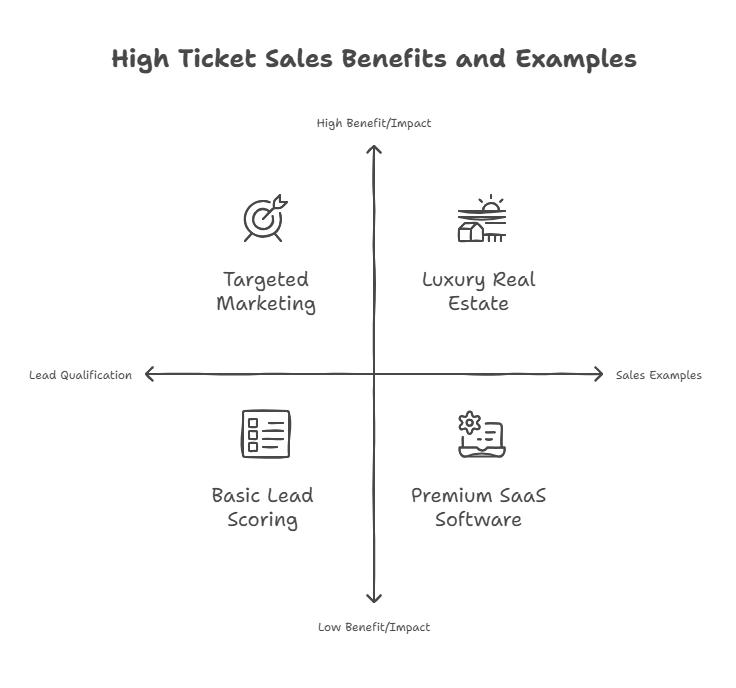
Best Way to Sell High-Ticket Digital Products
Finding profitable high-ticket digital products is just the first step. To maximize conversions and increase sales, you need an effective strategy that builds trust, demonstrates value, and attracts the right buyers.
Unlike low-cost products, high-ticket digital products require a more personalized approach. Customers won’t impulsively buy a $1,000+ product without clear proof of its value.
Build an Optimized Sales Funnel
A high-converting sales funnel guides potential buyers from awareness to purchase. Instead of sending people directly to a sales page, use a structured process that nurtures trust and answers objections.
Key Stages of a High-Ticket Sales Funnel:
- Lead Magnet – Offer a free resource (webinar, case study, free trial) to capture emails.
- Nurture Emails – Send value-driven emails to educate prospects before pitching the offer.
- Sales Call/Webinar – High-ticket sales often require live interaction to close the deal.
- Checkout Page – Use a well-designed landing page with testimonials and secure payment options.
Platforms like ClickFunnels, Kajabi, and Teachable provide pre-built funnels designed for selling high-ticket products.
Leverage Paid & Organic Traffic
Driving qualified traffic to your high-ticket offer is essential. Here are the best ways to attract serious buyers:
- SEO & Blogging – Rank for high-intent keywords related to your digital product using long-form, value-packed content.
- YouTube Content – Create in-depth video tutorials or case studies to position yourself as an authority.
- Email Marketing – Use automated email sequences to warm up leads before presenting the offer.
- Retargeting Ads – Use Facebook, Google, or YouTube ads to re-engage visitors who showed interest but didn’t purchase.
Successful high-ticket sales come from building trust first. Instead of directly pushing a product, focus on educating and providing value before presenting an offer.
Use Webinars & Personal Selling
Webinars and one-on-one sales calls are powerful tools for closing high-ticket deals. Since high-ticket buyers need more trust and reassurance, live sessions provide an opportunity to:
- Showcase the transformation and value of your product.
- Answer questions and handle objections in real-time.
- Offer exclusive bonuses or limited-time discounts to encourage immediate action.
Platforms like Demio and Zoom allow you to run high-converting webinars that drive sales effectively.
Selling high-ticket digital requires a structured funnel, the right traffic strategy, products and a personal approach.
Selling Low-Ticket vs. High-Ticket Digital Products
Selling digital products isn’t one-size-fits-all. The way you sell a $27 template is nothing like how you sell a $2,000 coaching program. Low-ticket sales rely on speed, volume, and impulse while high-ticket sales hinge on trust, proof, and authority.
| Factor | How Low-Ticket Sells | How High-Ticket Sells |
|---|---|---|
| Sales Process | Direct sales pages and quick checkouts; decisions made in minutes. | Funnels, webinars, or calls; buyers often need multiple touchpoints. |
| Buyer Mindset | Casual, testing the waters with low risk. | Serious, investing in transformation with clear ROI expectations. |
| Content Needed | Short descriptions, simple ads, quick blogs. | In-depth reviews, tutorials, case studies, and authority content. |
| Conversion Trigger | Discounts, urgency, and price anchoring. | Proof of value, social proof, testimonials, and trust in the seller. |
| Traffic Strategy | High volume, broad targeting, constant churn. | Lower volume, highly qualified leads with precision targeting. |
Why This Matters: If you treat a high-ticket product like a $27 eBook, you’ll struggle to sell. High-ticket buyers aren’t looking for discounts, they’re looking for transformation and proof. By understanding the differences in sales dynamics, you can shift your strategy, build stronger trust, and close fewer but far more profitable deals.
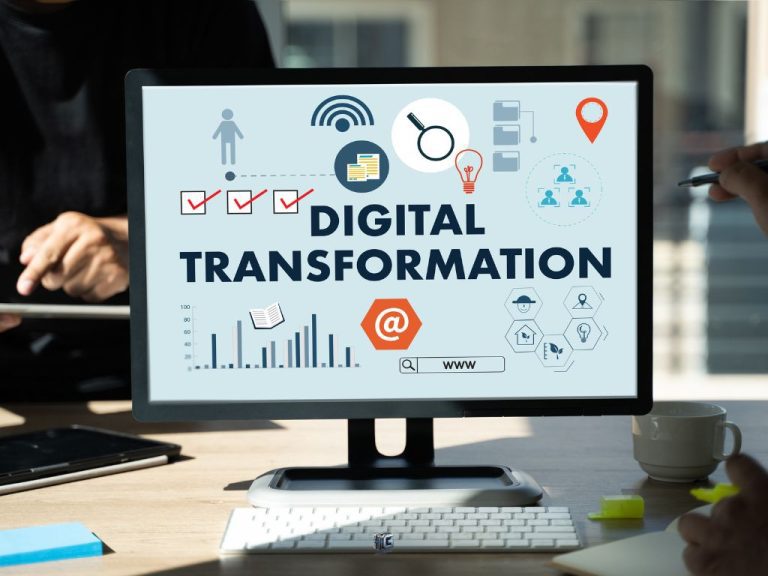
Pricing Strategies for High-Ticket Digital Products
Setting the right price for high-ticket digital products is crucial for maximizing profits while ensuring customers perceive the true value of what they’re purchasing.
Unlike low-ticket items, premium digital products require strategic pricing models that align with their impact, exclusivity, and transformation potential.
Value-Based Pricing vs. Competitor-Based Pricing
- Value-Based Pricing – Price is determined by the outcome and transformation the product provides, rather than its production cost. If a course helps students generate an additional $50,000 per year, a $5,000 price tag becomes reasonable.
- Competitor-Based Pricing – Prices are set based on what similar products charge in the market. This method helps stay competitive, but should be paired with unique value differentiation.
For high-ticket digital products, value-based pricing is often the best approach, as customers pay for results, not just content.
Psychological Pricing Techniques for High-Ticket Sales
- The $997 Strategy – Instead of pricing at $1,000, setting the price at $997 makes it psychologically more appealing while maintaining perceived high value.
- Tiered Pricing – Offering multiple packages with increasing value (e.g., standard, premium, and VIP tiers) allows customers to choose based on their needs.
- Payment Plans & Financing – Breaking down a $2,000 product into four payments of $500 makes the purchase feel more accessible, increasing conversion rates.
- Premium Positioning – A higher price can create exclusivity, signaling higher quality and attracting serious buyers rather than bargain shoppers.
Bundling & Upselling for Increased Revenue
Maximize revenue by combining high-ticket digital products with additional value-adds:
- Bundling Complementary Products – Pair an online course with exclusive coaching calls or access to a private mastermind group.
- High-Ticket Upsells – Offer an advanced training package or one-on-one coaching as an upgrade after the initial purchase.
- Lifetime Access vs. Subscription – Some customers prefer a one-time high-ticket purchase, while others may benefit from a monthly recurring subscription model.
Comparing Pricing Models for High-Ticket Digital Products
Here’s how the main pricing strategies stack up when it comes to selling premium digital offers:
| Pricing Model | Core Idea | Best For | Watch Out For |
|---|---|---|---|
| Value-Based | Price reflects the transformation or ROI delivered, not production costs. | Courses, SaaS, or coaching with measurable outcomes. | Requires strong proof (testimonials, case studies) to justify premium pricing. |
| Competitor-Based | Anchors your price against market leaders, then adds unique value. | Crowded niches where buyers compare multiple offers. | Risk of blending in if your differentiation isn’t clear. |
| Psychological | Uses pricing cues (e.g., $997 instead of $1,000, tiered packages, or payment plans). | Buyers who need reassurance or flexibility. | Overuse can feel manipulative if not backed by real value. |
| Bundling & Upselling | Combines core offers with add-ons (e.g., course + coaching, SaaS + support). | Products with natural complementary upgrades. | Bundles must feel premium not padded with filler. |
Takeaway: The best pricing strategy isn’t about squeezing numbers, it’s about aligning the cost with the transformation buyers expect. Pair value-based pricing with psychological nudges and bundles to boost conversions without undermining trust.

Platforms to Sell High-Ticket Digital Products
Choosing the right platform to sell high-ticket digital products is essential for maximizing conversions, automating sales, and ensuring a smooth user experience. The right platform will depend on whether you’re selling courses, software, memberships, or services.
Best Platforms for Selling High-Ticket Digital Products
1. Online Course & Coaching Platforms
For digital courses, coaching programs, and memberships, these platforms provide built-in payment systems, hosting, and automation tools:
2. SaaS & Digital Software Selling Platforms
For high-ticket SaaS tools and software licenses, these platforms offer recurring subscription options and customer management:
Gumroad – Simple solution for selling software and digital downloads.
Paddle – Handles payments, licensing, and tax compliance for SaaS products.
FastSpring – Provides subscription-based billing and global payment processing.
3. High-Ticket Sales Funnel Builders
If you’re selling a coaching program, premium software, or a done-for-you service, a high-converting funnel can increase your revenue per customer:
ClickFunnels – Best for creating conversion-focused funnels with upsells and order bumps.
Systeme.io – Affordable alternative for building complete marketing funnels.
Leadpages – Optimized for selling high-ticket services and digital products.
4. Marketplaces for Digital Products
For those looking for pre-existing audiences, marketplaces allow sellers to reach warm leads without heavy marketing:
Udemy – Good for affordable courses, but not ideal for high-ticket pricing.
Skillshare – Best for subscription-based learning communities.
Flippa – Useful for selling established digital businesses or SaaS products.
What to Consider When Choosing a Selling Platform
- Commission Fees – Some platforms take a percentage of each sale, reducing profits.
- Customization & Branding – Some platforms limit how much control you have over branding and the customer journey.
- Payment Processing – Ensure the platform supports credit cards, PayPal, and payment plans.
- Automation & Marketing Features – Built-in email marketing, funnels, and retargeting options can boost conversions.
Selecting the right platform ensures smooth transactions, higher conversions, and a scalable business model for selling high-ticket digital products.
⚡ Comparing Platforms for High-Ticket Digital Products
Each platform type comes with strengths and trade-offs. Use this table as a quick reference to match your product with the right selling system:
| Platform Type | Strengths | Weaknesses | Best Fit |
|---|---|---|---|
| Online Course & Coaching Platforms | All-in-one hosting, polished user experience, flexible pricing. | Monthly fees, limited funnel customization. | Course creators, coaches, and educators. |
| SaaS & Digital Software Platforms | Handles subscriptions, licensing, compliance, and global payments. | More technical setup, less built-in marketing support. | SaaS founders or affiliates promoting recurring tools. |
| Funnel & Sales Builders | Optimized for conversions, webinars, upsells, and authority-driven sales. | Requires strong content and steady traffic. | Marketers and affiliates relying on high-ticket funnels. |
| Marketplaces | Built-in audience, instant exposure, easy setup. | High fees, less branding control, harder to position as premium. | Beginners testing offers or seeking fast exposure. |
Takeaway: The right platform depends less on features and more on your business model. If you’re building a long-term brand, platforms like Kajabi or ClickFunnels are worth the investment. If you want speed and simplicity, marketplaces or plug-and-play software platforms may be a smarter first step.

Common Mistakes to Avoid When Selling High-Ticket Digital Products
1: Not Positioning the Product as High-Value
Customers invest in premium digital products based on perceived value. If your product is priced at $1,000+ but doesn’t look or feel premium, it will struggle to sell.
How to Fix It:
- Focus on branding, professional design, and high-quality content.
- Use case studies, testimonials, and transformation stories to demonstrate the product’s impact.
- Position the product as an exclusive, results-driven solution rather than just an informational product.
2: Relying Only on Direct Sales Pages
High-ticket products require trust before a buyer commits. Sending cold traffic directly to a sales page often leads to low conversions and abandoned carts.
How to Fix It:
- Use a structured sales funnel that includes lead nurturing, email sequences, and personalized interactions before the final sale.
- Implement webinars, sales calls, or live Q&A sessions to increase engagement and trust.
3: Not Offering Payment Plans or Financing
A one-time $2,000 payment can feel overwhelming for some buyers, even if they see the value. Without flexible pricing options, you risk losing potential customers.
How to Fix It:
- Offer payment plans (e.g., $500/month for 4 months) to make the product more accessible.
- Use third-party financing solutions like PayPal Credit or Klarna to break the price into smaller payments.
4: Ignoring Customer Support & Follow-Up
Since high-ticket digital products often involve personal investment, customers expect top-tier support. If they experience issues or don’t feel guided properly, they may request refunds or leave negative reviews.
How to Fix It:
- Provide dedicated customer support via email, chat, or exclusive community groups.
- Follow up with personalized onboarding emails to guide new customers through the product.
- Offer Q&A calls or private coaching options to ensure customer success.
5: Selling to the Wrong Audience
Not everyone is a fit for a high-ticket product. If you’re targeting people who can’t afford it or who don’t see the value, you’ll get low conversions and high refund requests.
How to Fix It:
- Qualify leads before pitching the offer through applications, quizzes, or initial consultations.
- Focus on audiences that already buy premium products, such as entrepreneurs, business owners, or high-level professionals.
Avoiding these mistakes dramatically increases conversion rates and customer satisfaction when selling high-ticket digital products. Proper positioning, trust-building, and structured payment options are key to long-term success.
⚠️ Common Mistakes at a Glance
| Mistake | Why It Hurts | Fix |
|---|---|---|
| Positioning like a low-ticket offer | Premium buyers won’t pay $1,000+ for something that looks basic or generic. | Invest in professional branding, design, and proof (case studies, testimonials). |
| Sending cold traffic to checkout | High-ticket buyers need trust and nurturing before committing. | Use sales funnels with lead magnets, nurture emails, and webinars. |
| No payment flexibility | One-time costs create friction and scare off qualified buyers. | Offer payment plans or financing options to reduce upfront barriers. |
| Weak support and follow-up | Premium customers expect premium service; poor support = refunds and negative reviews. | Provide onboarding, dedicated support, and consistent follow-up. |
| Targeting the wrong audience | Even the best product fails if buyers can’t afford or don’t need it. | Qualify leads with targeting, quizzes, or applications before pitching. |
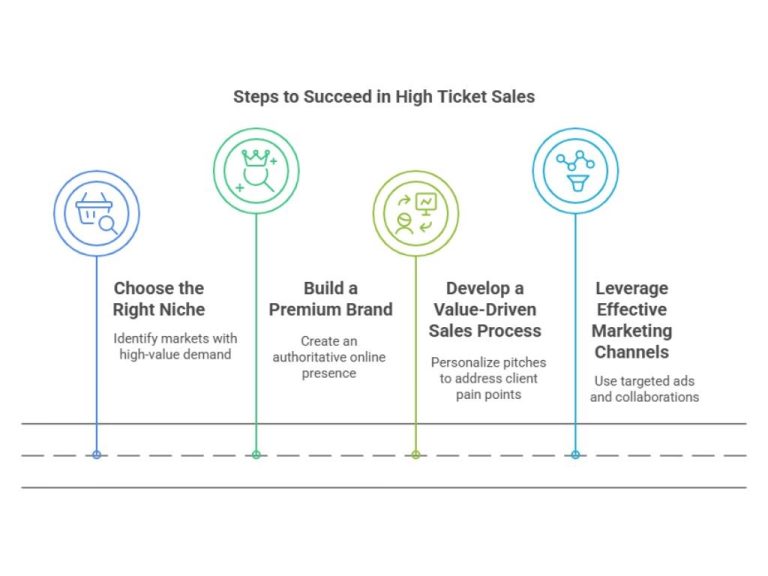
Final Thoughts: High-Ticket Digital Products
Selling high-ticket digital products is more than just making a sale, it’s about delivering real value to buyers who seek premium solutions. Unlike low-cost digital products, high-ticket offers require trust, credibility, and a well-structured strategy to attract and convert serious customers.
By focusing on high-value niches, leveraging optimized sales funnels, and using relationship-driven sales techniques, sellers can consistently generate substantial revenue while building a strong brand presence. Successful high-ticket sales rely on understanding the customer’s needs, providing proof of transformation, and offering a seamless buying experience that removes hesitation.
A well-positioned product, combined with effective marketing and customer support, ensures long-term profitability and sustainability. The opportunity to create a thriving business with high-ticket digital products is within reach for those willing to implement the right strategies, refine their approach, and stay committed to providing exceptional value.
🚀 Ready to start? Explore the best high-ticket programs and take action today!
Want to See the System That’s Quietly Paying 4-Figures per Sale?
It’s not a course. It’s not a mastermind. And it’s not for everyone.
But if you’re serious about selling premium offers this changes the game.
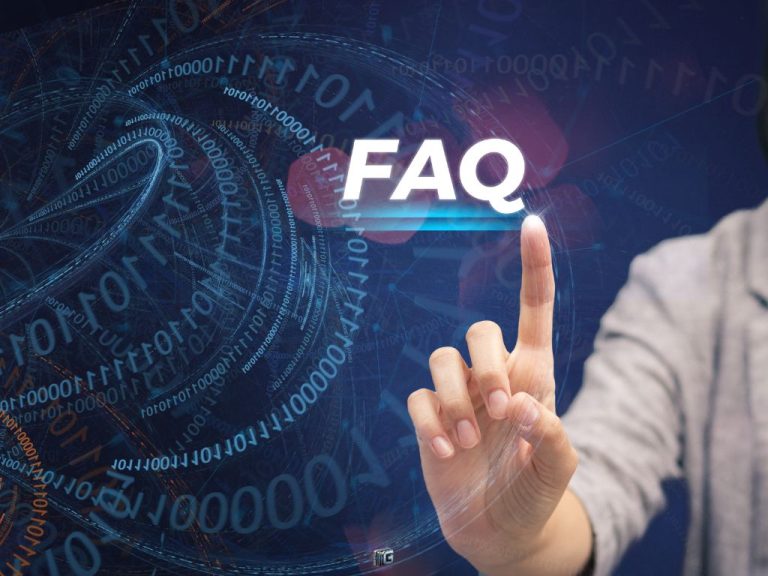
Frequently Asked Questions (FAQs)
What qualifies as a high-ticket digital product?
A high-ticket digital product is any online offering priced at $500 or more. These can include online courses, software subscriptions, business coaching, and exclusive membership programs.
Why are high-ticket digital products more profitable?
They generate higher earnings per sale, reducing the need for a large audience. Selling one $2,000 product requires fewer conversions than selling multiple $50 products.
How do I attract buyers for high-ticket digital products?
High-ticket buyers require trust and proof of value. The best strategies include webinars, case studies, social proof, and targeted email marketing.
Can I sell high-ticket digital products without a large following?
Yes, by using high-converting funnels, paid advertising, and strategic networking, you can attract qualified buyers without needing a massive audience.
What is the best platform to sell high-ticket digital products?
Platforms like Kajabi, ClickFunnels, Teachable, and Gumroad offer tools for selling, marketing, and automating the process. The right platform depends on whether you’re selling courses, software, or services.
Do I need to provide customer support for high-ticket digital products?
Yes, since high-ticket purchases require more trust, offering dedicated support, onboarding resources, and Q&A sessions can improve customer satisfaction and reduce refund requests.
Should I use payment plans when selling high-ticket products?
Yes, offering flexible payment options (such as monthly installments) increases conversions by making the product more accessible to a broader audience.
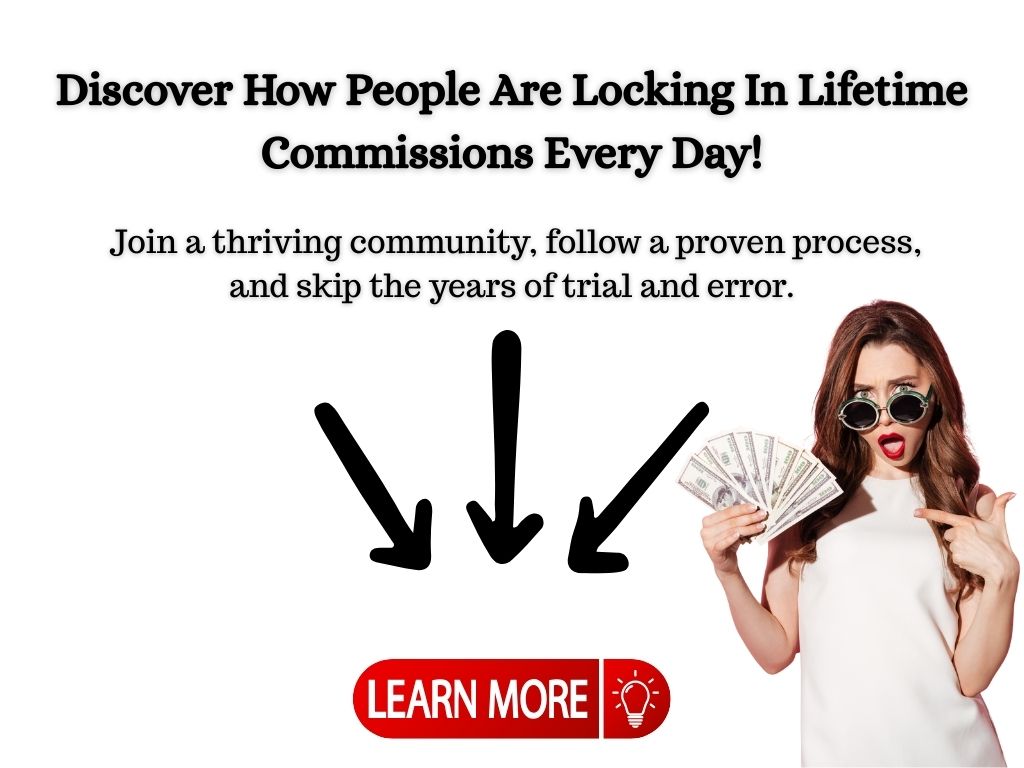
2 Comments
Digital Products: Guide to Selling, Marketing, and Scaling for 2025 - Ismel Guerrero. · March 16, 2025 at 7:19 pm
[…] Next, check out our High Ticket Digital Products Guide. […]
High Ticket Sales: How to Close Premium Clients - Ismel Guerrero. · April 12, 2025 at 12:29 pm
[…] offerings exist across a wide range of industries — learn more about different high ticket products and services to find the right fit for your […]